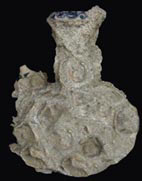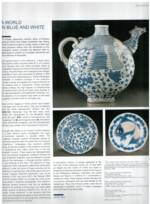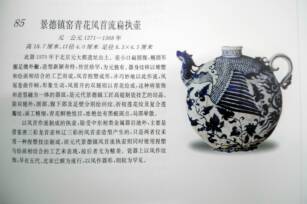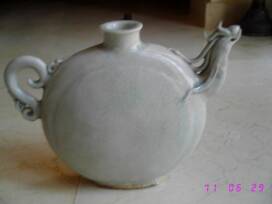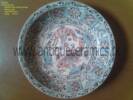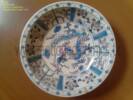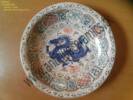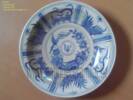 | ||||
Antiques or not-so antique after all?
These pages are created to hightlight what everyone knows already: Buying antiques on the internet is asking for it.
If you can say with certainty which of the two plates on the right is genuinely old -no need to go any further. If not, click here to find out.
Whom of us have gone into an antique shop assuming that everything for sale is antique? Not many I am sure! It is more likely that we suspect many pieces offered as 'antiques' are not so antique after all. So what do we do? Instead of concentrating on what we would like to buy, we try to be instant expert and determine what is genuine or not.
And that -as these pages will show, is not easy. Unless you are familiar with antique pottery and porcelain, assume you will be taken for a ride unless you buy from provenance sources.
These pages are made to provide some information about the differences between old and new and to few of the many tricks the 'fakers' of new -'look old' pottery offer.
As time permit, we will expand on the content and hopefully help some innocent buyers from buying new pierces for antique prices.
Ceramic pieces with shells and other marine growth has become immensely popular the last few years. In addition to being beautifully decorated by nature, such pieces appear genuinely old as well.
As shipwreck ceramics gains more popularity, the 'fakers' are not slow to respond to market demands. The kendi on the left was brought to us for verification.
Click here to see what was found after the 'natural marine growth' was partly removed.
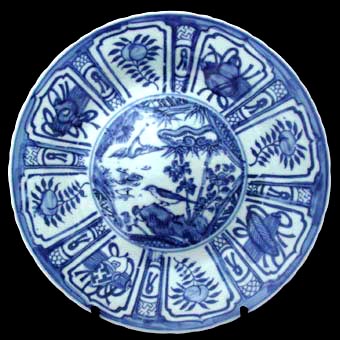
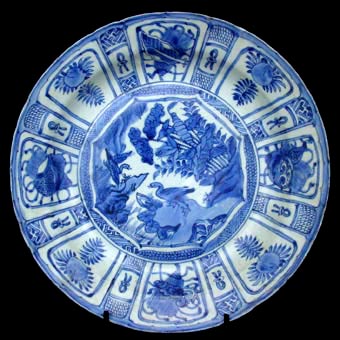
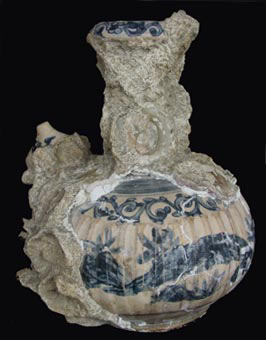
To view a National Geographic three part documentary about Chinese "fakers" and how clever they are, click here
 | ||||
CLICK ON IMAGES TO VIEW ARTIFACTS FOR SALE
You are not alone to have difficulties to determine what is fake and what is not. Recently one International well-known museum published a fake "Yuan dynasty" flask as genuine old. This was published in the museum's news letter which goes out to many art-students, museum patrons and supporters. To read the full story and our early opinion, go to our blog: http://www.mingwrecks.com/Blog.html The worst thing about this sad story is that the museum, now knowing that they published a fake bottle as a genuine historical artifact, still have not yet publicly corrected their mistake.
Tender edges , or as the Japanese more graphically described it, 'moth-eaten' edges is a technical fault in early 17th century porcelain. This effect is seen when the glaze breaks off in patches along sharp edges in a rather irregular manner and particularly common on the rims of bowls, dishes and plates. The cause is complex, but is mainly due to the physical properties of the raw materials and the varying surface tensions of the ingredients of the body and glaze. The fault was overcome in the later part of the 17th century when the potters adjusted the proportions of raw materials.
Tender edges is a commonly acceptable factor for authenticity and should not be mended, as a principle, as it adds to the provenance of the ware. The 'faking' of 'tender edges' is not possible as the edges of the broken off pieces cannot be made as sharp at the original.
Sten spent more than thirty years in Southeast Asia, primarily designing and engineering marine structures. Sten has an academics enthusiasm for ancient ceramics and has written numbers of books and lectured extensively in the subject.
An champion sailor and diver he has discovered a number of shipwreck in the South China Sea and assisted museums world-wide to exhibit and to collect meaningful ceramic collections.
Sten's company; Nanhai Marine Archaeology Sdn. Bhd. works with Malaysia's Department of Museums and Antiquities and can therefore offer a legal Export Permit from the Department when so required.
Sten has located number of ancient kiln sites in Thailand and in China were his shipwreck ceramics was made centuries ago. He is therefore able to offer absolute provenance on all ceramics sold via Nanhai Marine Archaeology Sdn. Bhd. and, with good concience sign every Certificate of Authenticity supplied with all artefacts.
The maritime archaeology of Sten Sjostrand has led to major advances in the study of Asian trade and trade ceramics in Southeast Asia. His meticulous documentation of a series of nine shipwrecks from the 11th to 19th centuries reveals the early dominance of Chinese trade ceramics, a subsequent loss of the Chinese monopoly in the late 14th century when Southeast Asian ceramics entered the market, the basic parameters of the Ming gap shortages of the 14th-15th centuries, and a resurgence of Chinese wares in the 16th and 17th centuries. Just as important, Sjostrand freely shares the information from his discoveries. Researchers are welcome at his headquarters where he documents his finds and patiently answers the queries of others. A lifetime’s experience with the sea and sailing allows Sjostrand to bring new understanding to ancient ship construction, and his voluminous reading allows him to set the ships and their cargoes in historical perspective.
Dr. Roxanna M. Brown
Director.
Southeast Asian Ceramics Museum
Bangkok University, Rangsit campus
Pathum Thani 12120, Thailand BACK TO TOP

 | ||||
CLICK ON BELOW IMAGES TO VIEW ARTIFACTS FOR SALE
The fake bottle published by the museum as a genuine historical artifact. Their reference piece is here shown in the middle picture
This is the genuine bottle as the museum refer to
in its article. This bottle was found in China and is absolutely genuine. Note the many differences in form, style of painting, spout, foot, handle to the published museum piece.
Here is another genuinely old bottle from the Yuan dynasty. This bottle was found on a shipwreck in Indonesia. Note the similarities in form to the other Chinese bottle. Check spout, mouth rim, handle etc.
WARNING!!!
Although it is not our policy to publish sites/people or organizations involved in selling 'fakes', this is one site where everything is fake. Even their "story" is unbelievable. Poor fishermen digging down their findings just to be be dug up centuries later!! There are no such poor fishermen in Indonesia. Secondly, the pieces they say are from ONE shipwreck vary about 300 year in age. Did the ship sink two times 300 year apart? The truth is more likely, looking at the style of decoration, (which I seen before) that these pieces are made in Bandung in Indonesia and has nothing to do with Ming dynasty or China.
Whatever you do, avoid any site with these pictures of this type of wares!
